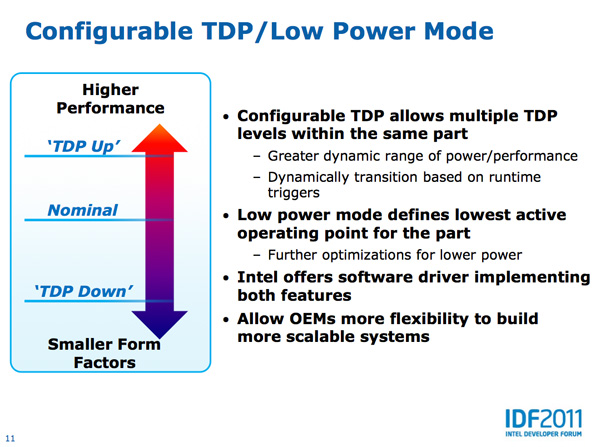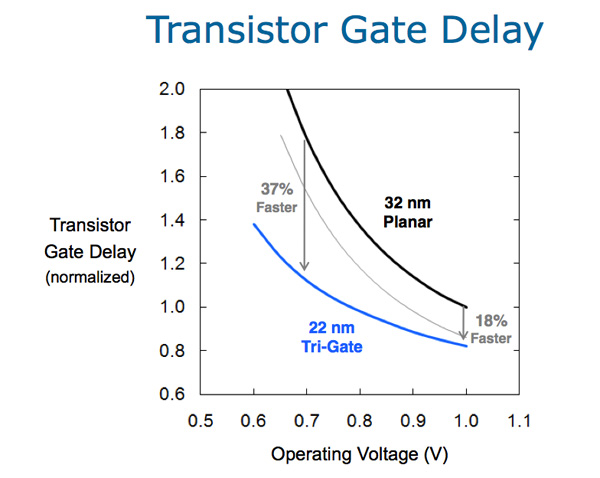Intel's Ivy Bridge Architecture Exposed
by Anand Lal Shimpi on September 17, 2011 2:00 AM EST- Posted in
- CPUs
- Intel
- Ivy Bridge
- IDF 2011
- Trade Shows
Power Efficiency Improvements
When Intel introduced its 22nm tri-gate transistors Intel claimed that it could see an 18% increase in performance at 1V compared to its 32nm process. At the same switching speed however, Intel's 22nm transistors can run at 75 - 80% of the voltage of their 32nm counterparts. Ivy Bridge's process alone should account for some pretty significant power savings. In addition to process however, there are a few architectural changes in IVB that will reduce power consumption.
Lower System Agent Voltages
Sandy Bridge introduced the System Agent, a name that used to refer to the uncore of a processor but now refers to the display output, memory controller, DMI and PCI Express interfaces. As of Sandy Bridge, the L3 cache was no longer included in the uncore and thus it wasn't a part of the System Agent.
The System Agent operates on a separate voltage plane than the rest of the chip. On Ivy Bridge Intel now offers even lower System Agent voltage options for the lower voltage SKUs, which in turn helps power optimize those SKUs.
More Accurate Voltage Characterization
Today Intel defines three different voltages for every Sandy Bridge CPU: LFM, nominal and turbo. LFM is the lowest frequency the CPU can run at (e.g. completely idle), nominal is the frequency it is specified to run at (e.g. 3.3GHz for a 2500K) and turbo is the highest available turbo frequency (e.g. 3.7GHz for a 2500K). Intel determines the lowest voltage possible for each one of those frequencies. Sandy Bridge obviously runs at more than just three frequencies, there are many more intermediate frequencies that it may run at depending on the current workload. The voltages at those intermediate frequencies are interpolated from the three points that I mentioned above.
With Ivy Bridge, Intel characterizes even more points along the frequency curve. Intel didn't reveal exactly how many points but it's more than three. A curve is then fit to the frequency/voltage data and depending on IVB's operating frequency a more accurate voltage point is calculated. The result from all of this seemingly simple work is a reduction in core voltage at these intermediate frequencies. Voltage changes have a cubic affect on power, so even a small reduction here can have a tangible impact. One of the points that wasn't previously characterized was max thread turbo. Ivy Bridge should be more power efficient in cases where you have all cores active.

Power Aware Interrupt Routing
This next feature is pretty neat. Ivy Bridge has logic to properly route interrupt requests to cores that are already awake vs. those that are asleep in their lowest power states. Obviously this approach can save a lot of power, however it may rob those active cores of some performance. IVB will allow prioritizing performance as well. Interrupt handling can thus be handled similarly to how it is today, or optimally for power savings.
Configurable TDP
I already wrote about what this is but if you missed our Pipeline post on it I'll briefly recap. All CPUs ship with a rated thermal design point (TDP) that tells OEMs what sort of cooling the chip requires. Traditionally that TDP value remained static and the CPU could do whatever it wanted but exceed that value. Ivy Bridge introduces configurable TDP that allows the platform to increase the CPU's TDP if given additional cooling, or decrease the TDP to fit into a smaller form factor.

The cTDP up mode is obviously for docked notebooks. You can imagine an Ivy Bridge notebook with an optional dock that could enhance the cooling capabilities of the machine. When undocked the notebook's processor would operate at a max TDP of 17W, for example, but toss it in a dock with additional cooling and the TDP would jump up to 33W. It's up to the OEMs to decide how they want to take advantage of this feature. It could be something as simple as a mobile dock with more fans, or something as complex as a modular water cooling solution with a bigger radiator in the dock. I haven't seen any concepts of systems that take advantage of Ivy Bridge's cTDP up support, but that's the theory.
What about cTDP down? Take the same 17W Ivy Bridge CPU from above but now drop the TDP to 13W, which in turn limits clock speed and voltage. Why would you want to do this? From the OEM perspective, Intel's TDP choices may seem arbitrary. Downwards configurable TDP allows OEMs to get a lower power configuration without forcing Intel to create a new SKU. OEMs can do this today through undervolting/underclocking of their own, but the cTDP down spec will at least give OEMs a guarantee of performance/power.
Configurable TDP obviously only applies to mobile Ivy Bridge. In particular the ultra low voltage and extreme edition parts will support cTDP. The cTDP values are listed in the table below:
| Ivy Bridge Configurable TDP | |||||
| cTDP Down | Nominal | cTDP Up | |||
| Ivy Bridge ULV | 13W | 17W | 33W | ||
| Ivy Bridge XE | 45W | 55W | 65W | ||
The most interesting are the 17W ULV Ivy Bridge parts as far as I'm concerned. Today you do sacrifice clock speed to get into the form factor of a MacBook Air. A clever OEM armed with Ivy Bridge might be able to deliver a cooling dock that would give you the best of both worlds: an ultra portable chassis on the go, and higher clock speeds while docked.











97 Comments
View All Comments
JonnyDough - Monday, September 19, 2011 - link
4-5 year old GPU? Heh, bud...most hardware takes years to develop. And the HD3000 series may be a bit dated but it makes even the XBox 360 look weak in comparison. Hardly dismal.moozoo - Saturday, September 17, 2011 - link
Does its GPU support double precision under OpenCL? i.e. cl_khr_fp64Does Trinity?
Ryan Smith - Saturday, September 17, 2011 - link
We don't have solid details on either one, but don't count on it. The reasons we don't see full FP64 support on non-halo GPUs are still in play for CPUs.Galcobar - Saturday, September 17, 2011 - link
Perhaps I'm missing something in the acronyms, but the table and text seems to disagree on the availability of SSD caching.The text states "All of the 7-series consumer chipsets will support Intel's Rapid Storage Technology (RST, aka SSD caching)."
The table, however, puts No under the Z75 column for Intel SRT (SSD caching).
As I understand things, you need RST (software) to support SRT (bound to the motherboard), but without SRT you don't get SSD caching.
Anand Lal Shimpi - Saturday, September 17, 2011 - link
Fixed :) SRT is only on the Z77/H77, not the Z75.Take care,
Anand
mlkmade - Saturday, September 17, 2011 - link
I know its really early to be talking about this cause ivy won't be out for awhile..but what about what amounts to be "ivyb-e" ? I'm sure details are very scarce...but will it follow the desktop path (both s1155) and be socket compatible? in this case s2011? if ivyb-e is socket compatible with sb-e...that'd be great..but by then all the chipset problems would be fleshed out huh..buy a new mono anywayAnand Lal Shimpi - Saturday, September 17, 2011 - link
I would hope so, but as of now there is no IVB-E on the roadmaps so anything I'd say here would be uninformed and speculative at this point :-/Take care,
Anand
ltcommanderdata - Saturday, September 17, 2011 - link
Does Ivy Bridge finally allow the IGP and QuickSync engine to be available even with a discrete GPU plugged in for both mobile and desktop without resorting to specific chipsets (ie. limited to the high-end chipset) or third-party software (relying on motherboard makers and OEMs to deal with Lucid)? WIth the IGP being OpenCL and DirectCompute capable, even if you have the latest Quad SLI/Crossfire setup it would be useful to have the IGP help out in GPGPU tasks.And it's interesting that with AMD introducing a beefier form of SMT with two full integer cores, Intel decided not to similarly increase hardware resource duplication to expand Hyperthreading. Instead Intel is focusing on improving single threaded performance by making sure a single thread can use all the resources if Hyperthreading is not needed. Seeing most software isn't making use of 8 simultaneous threads, focusing on making 4 threads (1 per core) work as fast as possible does make sense.
Meegulthwarp - Saturday, September 17, 2011 - link
"As we've already seen, introducing a 35W quad-core part could enable Apple to ship a quad-core IVB in a 13-inch MacBook Pro." Here is to hoping that someone other than apple will also ship a decent 13-inch with a quad.Other than that great insight, I really hope the GPU on IVB will be half way useable. I think we've hit a point where CPU performance is more than adequate for 95% of consumers. Now just need to up the GPU performance and get power down so we can use our laptops on battery all day. I'm more than happy with my 2 year old C2D CPU performance but want battery life, hugely tempted with AMD's A6-3400M. But with Bulldozer looming I think I may hold back for 6 months.
Anand Lal Shimpi - Saturday, September 17, 2011 - link
I hope so too, I simply used Apple as an example because it has migrated to quad-core in every member of its MBP family with the exception of the 13-inch. I've updated the statement to be a bit more broad :)Take care,
Anand